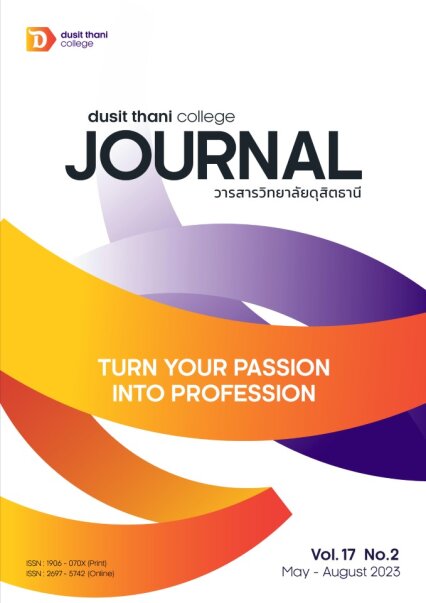แนวทางการบริหารร้านอาหารไทยเพื่อส่งเสริมการท่องเที่ยวเชิงอาหารสำหรับผู้สูงอายุในกรุงเทพมหานคร
Main Article Content
บทคัดย่อ
การวิจัยนี้ มีวัตถุประสงค์เพื่อศึกษาแนวทางจัดการธุรกิจอาหารไทยในการส่งเสริมการท่องเที่ยวเชิงอาหารสำหรับผู้สูงอายุชาวไทยเขตกรุงเทพมหานคร เป็นการวิจัยเชิงคุณภาพที่ใช้วิธีการสัมภาษณ์แบบกึ่งโครงสร้าง (Semi-structured Interview) โดยการสัมภาษณ์แบบสนทนาอย่างไม่เป็นทางการ (Informal Interview) กับผู้ที่มีส่วนได้ส่วนเสีย ทั้งภาครัฐและภาคเอกชน จำแนกออกเป็น 3 กลุ่ม ได้แก่ ผู้แทนภาครัฐ ผู้แทนเอกชน และผู้แทนภาคนักวิชาการ รวมทั้งสิ้น 24 คน ผลการศึกษาพบว่า กระบวนการจัดการธุรกิจอาหารไทยสำหรับผู้สูงอายุ เพื่อส่งเพื่อส่งเสริมการท่องเที่ยวเชิงอาหารในกรุงเทพมหานคร ภายใต้แนวคิด A SIMPLE Model มีกรอบแนวคิด คือ “ความไม่ซับซ้อน นำกลับไปสู่ความเป็นธรรมชาติและแก่นรากฐานที่แท้จริงของมนุษย์ คือความสุขที่ถ่องแท้ ของการท่องเที่ยวเชิงอาหารของผู้สูงอายุ” ประกอบด้วย 6 กลยุทธ์ คือ 1) Activity (A) คือ กิจกรรม 2) Sustainability (S) คือ ความยั่งยืน 3) Ingredients (I) คือ การสรรหาวัตถุดิบ 4) Menu Planning and Design (M) คือ แนวทางการวางแผนและออกแบบ 5) Physical (P) คือ ลักษณะทางกายภาพ 6) Location (L) คือ ทำเลที่ตั้งของอาหารและเครื่องดื่ม 7) Empathy (E) คือ การเอาใจใส่
Article Details

อนุญาตภายใต้เงื่อนไข Creative Commons Attribution-NonCommercial-NoDerivatives 4.0 International License.
นโยบายการพิจารณากลั่นกรองบทความ
- บทความวิจัยและบทความวิชาการทุกเรื่องที่จะได้รับการตีพิมพ์ต้องผ่านการพิจารณากลั่นกรองโดยผู้ทรงคุณวุฒิ (Peer Review) ในสาขาที่เกี่ยวข้อง จำนวน 3 ท่าน/บทความ
- บทความ ข้อความ ภาพประกอบและตารางประกอบที่ลงตีพิมพ์ในวารสารเป็นความคิดเห็นส่วนตัวของผู้เขียน กองบรรณาธิการไม่จำเป็นต้องเห็นด้วยเสมอไป และไม่มีส่วนรับผิดชอบใด ๆ ถือเป็นความรับผิดชอบของผู้เขียนแต่เพียงผู้เดียว
- บทความที่จะได้รับการตีพิมพ์จะต้องไม่เคยตีพิมพ์ เผยแพร่ที่ใดมาก่อน และไม่อยู่ระหว่างการพิจารณาของวารสารฉบับอื่น หากตรวจสอบพบว่ามีการตีพิมพ์ซ้ำซ้อน ถือเป็นความรับผิดชอบของผู้เขียนแต่เพียงผู้เดียว
- บทความใดที่ผู้อ่านเห็นว่าได้มีการลอกเลียนหรือแอบอ้างโดยปราศจากการอ้างอิง หรือทำให้เข้าใจผิดว่าเป็นผลงานของผู้เขียน กรุณาแจ้งให้กองบรรณาธิการวารสารทราบจะเป็นพระคุณยิ่ง
เอกสารอ้างอิง
Chewasopit,W (2019). Aging Society: The Changed Marketing Factor. Journal of Mcu Nakhondhat, 6(1), 38-54.
Cousins, J., Lillicrap, D., & Weekes, S. (2017). Food and beverage service. Hachette UK.
customers: Exploring similarities and differences. International Journal of Hospitality & Tourism Administration, 17(1), 1-26.
Denzin, N. K. (1970). Problems in analyzing elements of mass culture: Notes on the popular song and other artistic productions. American Journal of Sociology, 75(6), 1035-1038.
Districts. Economics and Business Administration Journal Thaksin University, 12(1), 65-82
Drysdale, J. and Galipeau, J. (2014). Profitable Menu Planning (Vol. 4). New York: Prentice Hall.
Elder Care Thailand. (2019). Nutrition for the elderly. Retrieved: July, 18 2020 from: http://www.eldercarethailand.com/index.php?option=com_content&task=view&id=43&Itemid=8
Jin, N. and Lee, S., 2016. The impact of restaurant experiences on mature and nonmature customers: Exploring similarities and differences. International Journal of Hospitality & Tourism Administration, 17(1), pp.1-26.
Jones, P. (2018). Aging Society: Opportunities and Encouragement. Business Review Journal, 10(1).
Knutson, B. J., Beck, J., and Elsworth, J. (2006). The two dimensions of restaurant selection important to the mature market. Journal of Hospitality & Leisure Marketing, 14(3), 35-47.
Kotler, P., Bowen, J. and Makens, J. (2017). Marketing for hospitality and tourism (Vol. 7). New Jersey: Prentice Hall.
Lee, J. E., & Severt, D. (2017). The role of hospitality service quality in third places for the elderly: An exploratory study. Cornell Hospitality Quarterly, 58(2), 214-221.
Lee, S., and McCleary, K. (2013). The relationship between perceived health, health attitude, and healthy offerings for seniors at family restaurants. Cornell Hospitality Quarterly, 54(3).
Lee, T.J., Cho, H. and Ahn, T.H., 2012. Senior citizen satisfaction with restaurant service quality. Journal of Hospitality Marketing & Management, 21(2), pp.215-226.
Mahidol University Research Center. (2561). AWUSO Society 4.0 Old but young at hearth. Retrieved: July 20, 2020, from: http://www.cmmu.mahidol.ac.th/cmmu/index.php/9-college-news/540-awuso-society-4-0
Ministry of Tourism and Sports (2020). Number and monthly income of foreign tourists between 2016-2019. Retrieved: July, 18 2019 from: https://www.mots.go.th/more_news_new.php?cid=585
Oluwatuyi, O., & Ileri, O. N. (2016). Cultural tourism and community involvement: Impacts
on sustainable tourism development in Ekiti State, Nigeria. Donnish Journal of Geography and Regional Planning, 2(1), 1-8.
Punturee, P. (2015). Tourist Experience: The Creation of Food Tourism Activities in Thailand. Journal of Southern Technology, 8(2), 27-38.
Shalini, D. and Duggal, S. (2015). A review on food tourism quality and its associated forms around the world. African Journal of Hospitality, Tourism and Leisure, 4(2).
Tatchawadeekittireuk, K., Keawsurapon, N., Pengman, H. (2020). Factors Affecting the Decision to Purchase Health Supplements for Elders in Hat Yai and Muang Songkhla. Journal Thaksin University, 12(1), 65-82
Techsauce. (2563). Wongnai for Business revealing that 97% of new restaurants are opening up, while the spicy salad menu is at the top of the search results. Retrieved: September, 15 2020, from https://techsauce.co/pr-news/wongnai-for-business
The Situation of Thai Older Persons (2017). Situation of the Thai elderly in 2016. Nakhon Pathom: Printer.
Ullphothong, L. and Sopha, C. (2012). Gastronomic tourism in Ayutthaya, Thailand. Retrieved: November 12, 2020, from https://www.semanticscholar.org/paper/GASTRONOMIC-TOURISM-IN-AYUTTHAYA%2C-THAILAND-Rajabhat/
b00612102b8569311f763e2ad39151a1edd66c6b


